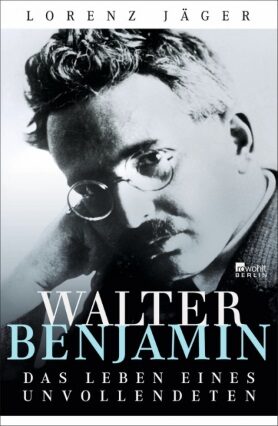Lorenz Jäger
Walter Benjamin. Das Leben eines Unvollendeten
[Walter Benjamin: An Unfinished Life]
- Rowohlt Buchverlag
- Reinbek bei Hamburg 2017
- ISBN 978-3-87134-821-1
- 398 Pages
- Publisher’s contact details
Lorenz Jäger
Walter Benjamin. Das Leben eines Unvollendeten
[Walter Benjamin: An Unfinished Life]
Published in Arabic with a grant from Litrix.de.
Sample translations
The Aura of the Intellectual
Lorenz Jäger’s biography of Walter Benjamin presents the messianism and materialism of a radical thinker whose aim was to combine the political, aesthetic and theological
The huge impact of his work would unfold only after his death, entire generations of students being socialized with The Work of Art in the Age of Mechanical Reproduction, the flâneur of his Arcades Project, his One-Way Street and the "angel of history" in his Theses on the Philosophy of History. He was – and is – venerated as an unorthodox thinker associated with the Frankfurt School and critical theory, a luminary interested in deconstructing the "aura."
This new biography of Walter Benjamin, written by publicist and long-time editor of the Frankfurter Allgemeine Zeitung Lorenz Jäger, emphasizes the intellectual development of a philosopher whose unfinished work – the book’s subtitle is "An Unfinished Life" – is equally marked by messianic and materialist approaches. The cultural critic’s range of topics was immense: from graphology to Dadaism and Surrealism, from Baroque tragedies and their obsession with death to the silent language of things and the obscure consumer world of Paris shopping arcades. "From the very outset his metaphysics had the potential, indeed a strong tendency to suddenly shift into a peculiar materialism of ‘things’ – and his messianism was strangely linked to an inner-worldly, secular promise of happiness," writes Jäger about the cultural critic who had hoped for something radically new. In 1913–4 Benjamin wrote "The Metaphysics of Youth," and in 1917, as a twenty-five-year-old, a strikingly self-confident "Program of the Coming Philosophy."
But Jäger begins by describing Benjamin’s origins, his birth in 1892 into a Berlin merchant family. Jäger briefly sketches the upper-class assimilated environment of his childhood and his reformist adolescence, before going into more detail about the friendships of his university years. In 1915 he met the math student and future historian of religion and Kabbala scholar Gershom Scholem, who emigrated to Palestine in 1923. Jäger uses this friendship to illustrate how Benjamin grappled with his Jewishness.
"The cultural environment that Benjamin lived in from 1915 to 1925 was marked by the imminent expectation of tremendous world-historical events and changes. Zionism was about to put an end to almost two thousand years of exile for the Jewish people." Unlike Scholem, who became a Zionist early on and radically broke with the assimilation of his parents’ home, "Jewishness played but a minor role" in Benjamin’s life, as he wrote in a letter to Ludwig Strauss. He had little use for "Emigration Zionism" or "National Jewishness."
Jäger emphasizes the personal relationships that repeatedly had a formative intellectual influence on Benjamin. In Switzerland, where he lived with his wife Dora from 1917 to 1919 and worked on his dissertation, he was deeply impressed by the philosopher Ernst Bloch. In 1924 he met Asja Lācis on the island of Capri, "a Bolshevist Latvian woman from Riga" who acted like a "communist electrical shock" on him. In the late 1920s he came into contact with Brecht and intensified his engagement with Marxism. Later, in the mid-1930s, he sought his "salvation in demagification." He focused on the commodity, and "in a chilly, almost compulsive way his findings are projected onto the motif of capitalism," Jäger concludes regretfully. The flâneur and creator of scintillating concepts increasingly concentrated on a "ruthlessly fixed idea."
The biography, however, is less focused on the chronological stages in Benjamin’s life than on "metaphysical upheavals"; his family setting plays less of a role than the intellectual worlds he moves in. It is fascinating how Jäger describes the cultural critic’s shifts between thing and commodity, and highly original the way he substantiates his "physiognomic" take on the philosopher using impressions from contemporaries – from Adorno to photographer Gisèle Freund and chiromancer Charlotte Wolff – without our having to agree with this physiognomic reading. Unlike previous biographers, Jäger mainly concentrates on the Benjamin intensely interested in the fringes of knowledge, in the merging of political, aesthetic and theological thought. In doing so he approaches his subject in a highly illuminating fashion without ever adopting a hagiographic tone.
Translated by David Burnett

By Jutta Person
Jutta Person, born 1971 in South Baden, studied German, Italian and Philosophy in Cologne and Italy, and gained a doctorate with a dissertation on the history of physiognomy in the 19th century. A journalist and cultural commentator, she is based in Berlin and writes for the Süddeutsche Zeitung, Die Zeit and Philosophie Magazin. From 2004 to 2007 she was an editor at Literaturen; since 2011 she has been in charge of the books section at Philosophie Magazin.
(Updated: 2020)
Publisher's Summary
Walter Benjamin’s work – still unfinished when he committed suicide – is not easy to label, or assign to a particular philosophical school. And yet he is among the most influential thinkers of the 20th century, with intellectuals such as Adorno or Kracauer professing to be in awe of his genius. Lorenz Jäger’s remarkable and exhaustively researched book recounts the story of an exceptional life and details his childhood as son of a Jewish art dealer; his student years in Freiburg and Berlin where his stimulating friendship with Gershom Scholem began and examines his strained relationship with the thinkers of the Frankfurt School. Benjamin then travelled to Moscow, where he carefully edged closer to the communist movement. While in Paris, he debated with Hannah Arendt and worked on Passages, his planned magnum opus, which remained fragmentary. He fled France in 1940 to avoid being handed over to the Germans, reaching the Spanish town Portbou, where he took his own life. The circumstances surrounding his death are as mysterious as much of the rest of his life and writing.
Jäger’s masterful narrative brings the story of Walter Benjamin vividly to life, while simultaneously offering an absorbing survey of the first half of the last century, depicting Berlin’s well-off Jewish society, the intellectual circles of the Weimar Republic as well as the horrors of exile and persecution. This electrifying biography provides new perspectives on the life and work of one of Europe’s major thinkers.
This electrifying biography provides new perspectives on the life and work of one of Europe’s major thinkers.
(Text: Rowohlt Buchverlag)
